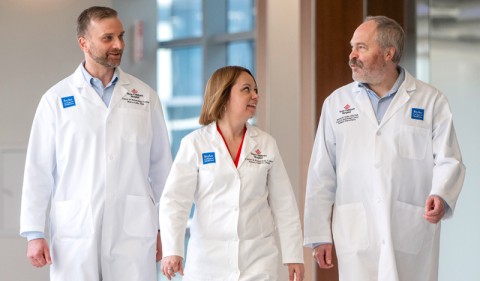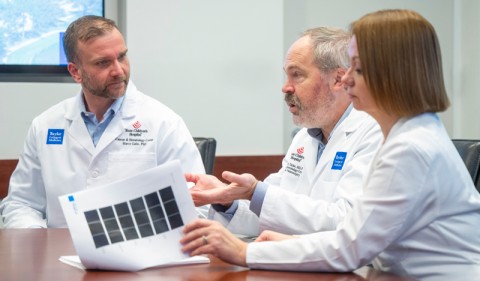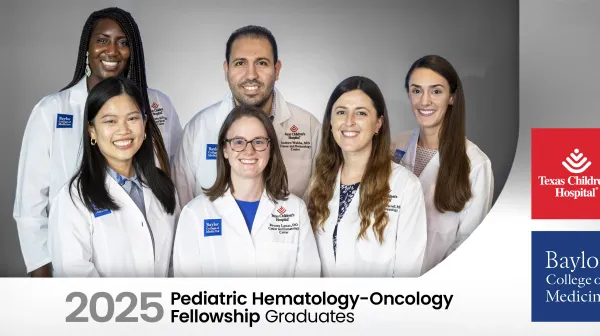
Researchers at Texas Children’s Pediatric Brain Tumor Research Program (L-R): Michael Taylor, MD, PhD, FRCS(C); Tamra Werbowetski-Ogilvie, PhD; and Marco Gallo, PhD.
The Pediatric Brain Tumor Research Program (PBTRP) at Texas Children’s Cancer Center is advancing research to improve outcomes for children diagnosed with central nervous system tumors. Close collaboration between clinicians and research scientists facilitates the rapid identification of potential targets and translation into precisely targeted therapeutic approaches, paving the way for improved survival rates and the potential for decreasing treatment-related morbidity.
Recent studies in leading journals highlight the program’s continued success at uncovering the mechanisms that drive two of the most devastating malignant pediatric brain tumors – medulloblastoma and ependymoma.
A novel approach to attack and kill the cells that give rise to Group 3 medulloblastoma
A collaborative study by Texas Children’s Hospital, Baylor College of Medicine, and other institutions has identified a population of stem-like cells responsible for the development and maintenance of Group 3 medulloblastoma (Gr3-MB), which is known for its aggressive nature and poor prognosis.
The study published in Cell revealed that these stem-like cells, which are embedded in the developing cerebellum, appear to establish a symbiotic relationship with immature blood vessels to create a niche that supports tumor growth.
The research team found that the stem-like cells express a protein, called protogenin, that is exclusively expressed in Gr3-MB tumors. These collective findings resulted in the development of a chimeric antigen receptor (CAR) T-cell, to selectively target protogenin. Preclinical studies of this CAR T-cell approach showed promising results in preclinical models and are paving the way for a new therapeutic approach.
“Our goal was to eliminate the cancer stem-like cells sustaining the tumor, akin to dissolving an army by assassinating its leaders,” said Michael Taylor, MD, PhD, FRCS(C), the study’s corresponding author and Director of the PBTRP at Texas Children’s Cancer Center.
Their model shows that these stem-like cells are present in a specific region of the cerebellum as early as the first trimester of human pregnancy. Thus, future goals extend beyond treatment of symptomatic tumors and offer the possibility of preventative therapies.
“In the future, we envision screening newborns for the persistence of these stem-like cells. If detected, protogenin-based strategies could eliminate them early, stopping this devastating disease in its tracks,” adds Dr. Taylor, who is also the Cyvia and Melvyn Wolff Chair of Pediatric Neuro-Oncology at Texas Children's Cancer and Hematology Center; Professor of Pediatrics, Hematology-Oncology at Baylor; and Scholar at the Cancer Prevention and Research Institute of Texas.
Unveiling the role of OTX2 in medulloblastoma progression

Another recent medulloblastoma study, published in Nature Cell Biology, is the first study to link alternative splicing to the development of medulloblastoma.
The researchers explored an unexpected role for the OTX2 transcription factor in driving medulloblastoma. Researchers at Texas Children’s, alongside colleagues from Baylor College of Medicine and the University of Manitoba, discovered that OTX2 influences not only gene transcription, but also alternative splicing – a process that enables cells to produce different proteins from the same genes.
The study showed that OTX2 interacts with splicing factors, creating protein variants that drive medulloblastoma stem cell growth. “Medulloblastoma stem cells serve as the root of the disease. Because of that, we focus on innovative ways to target these cells,” said co-corresponding author Dr. Tamra Werbowetski-Ogilvie, Professor of Pediatrics, Hematology-Oncology at Baylor and Texas Children’s.
By linking alternative splicing to the development of medulloblastoma, the study reveals new avenues for targeting the cancer. The focus of the study was the gene PPHLN1, which is present in various forms due to OTX2-mediated alternative splicing. By targeting PPHLN1 splicing using a drug known as a morpholino, the team was able to increase survival in preclinical models.
This breakthrough expands our understanding of medulloblastoma beyond traditional gene expression, highlighting the importance of protein variants in cancer progression.
Targeting unique 3D genome structures to fight PFA ependymomas
A third study led by researchers at Texas Children’s and Baylor College of Medicine, published in Cell, investigated the 3D genome architecture of posterior fossa group A (PFA) ependymomas. These tumors primarily affect very young children, and current therapies are limited to radiation, which carries the risk of severe cognitive and developmental side effects in long-term survivors.
The team used Hi-C genomic technology to analyze DNA folding in PFA ependymoma cells. They discovered unique, compact genomic regions called TULIPs (type B ultra-long interactions in PFAs). The tightly packed 3D structure of TULIPs enables DNA to interact over long distances within the nucleus.
“The uniqueness of TULIPs in these high-risk tumors has motivated us to investigate whether targeting them might promote tumor elimination,” said Marco Gallo, PhD, Associate Professor, Hematology-Oncology at Baylor and Texas Children’s. “In PFA patient-derived cell cultures, we found that inhibiting the tagging of histone H3K9 weakens interactions between TULIPs and decreases the survival of the cancer cells.”
This research offers a promising new target for therapy. By disrupting TULIPs, tumor progression may be halted, providing a new hope for children diagnosed with this difficult-to-treat tumor.
A collaborative approach to innovation

These studies exemplify Texas Children’s approach to tackling pediatric brain tumors through cutting-edge research. Each of these findings brings hope for more effective treatments, showcasing the program’s commitment to translating basic scientific discoveries into clinical solutions. Exploring molecular pathways, from protein interactions to 3D genome structures, is crucial to developing therapies that prolong survival and improve quality of life for young patients.
For pediatric oncologists and researchers interested in learning more about innovative cancer research trials at Texas Children’s, explore our current and featured trials filtered by research area.





